| Obverse | Reverse | Description |
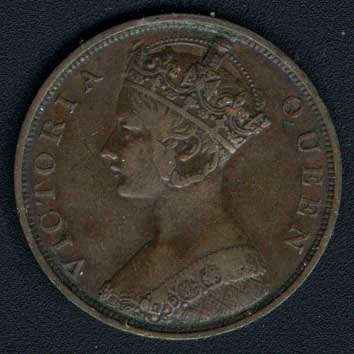
|
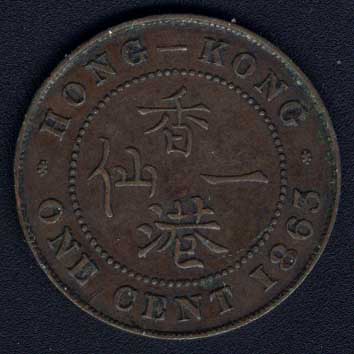
|
No. 112 |
|
Diam. 27 mm |
||
| Wt. 7.5 g. | ||
| Rareness C | ||
| Mint Evolution and Peculiarity | ||
|
The inscriptions bearing on the obverse of this coin are Victoria
Queen crowned bust left [Type 1]. There are fourteen pearls on
the left arch of the crown (fifteen in Type 2). On the reverse
of this coin are four Chinese characters means Hong Kong one
cent, in the center of a beaded circle. Characters HONG - KONG
above and ONE CENT 1863 below the circle. People of Hong Kong always took this type of coins into the adjacent Kwangtung territory, where they were often sold at the rate of seven or eight hundred for a silver dollar. This western style coinage in Hongkong directly influenced the Chinese mint authority in Kwangtung Province, they decided to mint the copper coin "T'ung Yuan" in order to solve the problem of the shortage of the copper cash in circulation in Kwangtung Province. |
||
| Obverse | Reverse | Description |
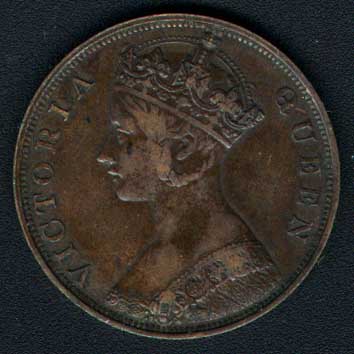
|
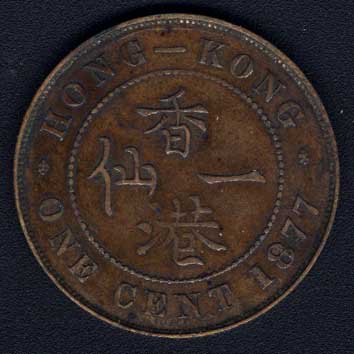
|
No. 380 |
|
Diam. 27 mm |
||
| Wt. 7.5 g. | ||
| Rareness D | ||
| Mint Evolution and Peculiarity | ||
| The inscriptions bearing on the obverse of this coin are Victoria Queen crowned second bust. Similar to first type but slightly older portrait of the Queen. More pronounced nostrils and a more rounded chin, with a thicker neck. A lock of hair hangs down onto the neck, and the ear is partly covered by hair. The crown of this Hong Kong 1877 coin is slightly taller with fifteen pearls on the left arch (fourteen in Type 1). | ||
| Obverse | Reverse | Description |
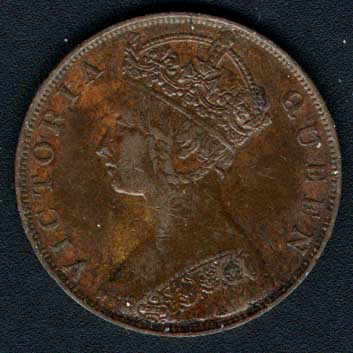
|
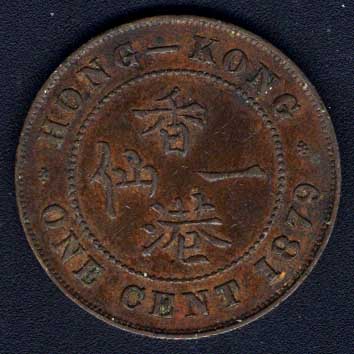
|
No. 381 |
|
Diam. 27 mm |
||
| Wt. 7.5 g. | ||
| Rareness D | ||
| Mint Evolution and Peculiarity | ||
| The inscriptions bearing on the obverse of this coin are Victoria Queen crowned second bust. Similar to the above 1877 coin, but the hair style is not the same as before, especially, the queue is rearranged on the hair tuft. Some of the 1879 Cent were used the third bust [Type 3] which designed with five pearls on centre of crown in lieu of three on types 1 and 2. | ||
| Obverse | Reverse | Description |
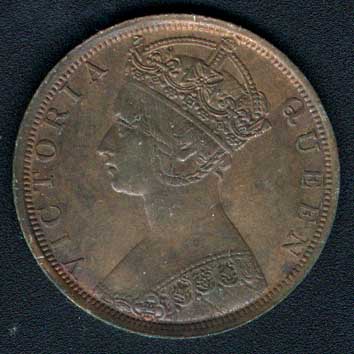
|
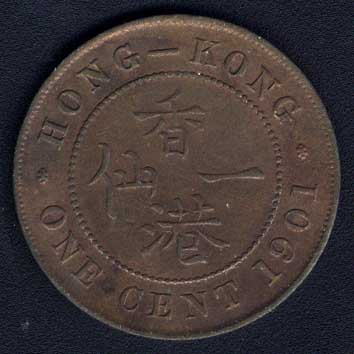
|
No. 331 |
|
Diam. 27 mm |
||
| Wt. 7.5 g. | ||
| Rareness D | ||
| Mint Evolution and Peculiarity | ||
| The inscriptions bearing on the obverse of this coin are Victoria Queen crowned bust left. This is the third bust [Type 3] which designed with five pearls on centre of crown. This also is the last issuing of one cent coin which bearing the portrait of the Queen Victoria. On the reverse of this coin are four Chinese characters means Hong Kong one cent, in the center of a beaded circle. Characters HONG - KONG above, ONE CENT 1901 below the circle and there is no mintmark below or above hyphen. | ||
| Obverse | Reverse | Description |
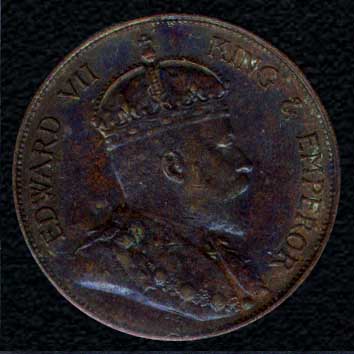
|

|
No. 113 |
|
Diam. 27 mm |
||
| Wt. 7.5 g. | ||
| Rareness D | ||
| Mint Evolution and Peculiarity | ||
| This coin is known as King Edward VII One Cent coin. Inscriptions on the obverse are King Edward VII crowned bust right and characters EDWARD VII KING & EMPEROR. The image of Edward VII King was designed by G.W. de Saulles [Engraver of the Royal Mint] who designed Edward's British coins too. Inscriptions on the reverse are same as those used during the latter part of Queen Victoria's reign except the issued date is 1905 instead of 1901. "H" mintmark below hyphen on reverse indicated that this coin was minted in R. Heaton and Sons Ltd. [now The Mint, Birmingham Ltd. Another mintmark is "KN" which reprsenting those coins struck at the King's Norton Metal Co., Ltd.] | ||
| Obverse | Reverse | Description |
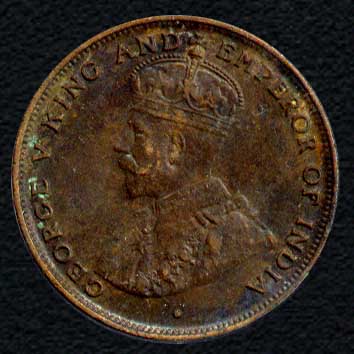
|
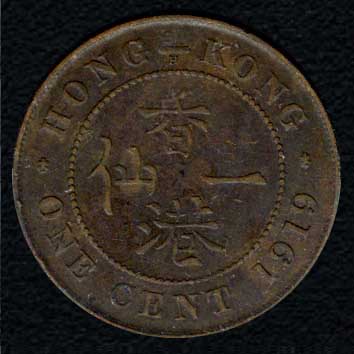
|
No. 114 |
|
Diam. 27 mm |
||
| Wt. 7.5 g. | ||
| Rareness E | ||
| Mint Evolution and Peculiarity | ||
|
As I know that very few coins were issued for Hong Kong during
the reign of George V. One cent coins were occasinally issued
after 1919. For the 4 years between 1923 to 1926, the issuing
of one cent coins were only 12,500,000 pieces. This coin was minted by Birmingham Mint. This is the first coin bore an image of King George V. Inscriptions on the obverse of this coin are King George V crowned bust left, dot below bust. GEORGE V KING AND EMPEROR OF INDIA. Inscriptions on the reverse are characters HONG-KONG ONE CENT 1919, and four Chinese characters within abeaded circle. "H" mintmark located below the hyphen. Mintage of one cent coins: 1919 - 2,500.000 | 1923 - 2,500,000 | 1924 - 5,000,000 | 1925 - 2,500,000 | 1926 - 2,500,000 pieces |
||
| Obverse | Reverse | Description |
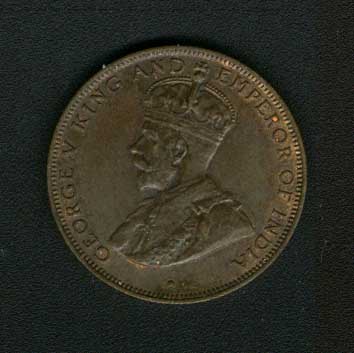
|
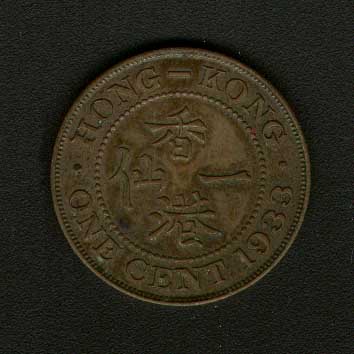
|
No. 338 |
|
Diam. 21.5 mm |
||
| Wt. 4g. | ||
| Rareness E | ||
| Mint Evolution and Peculiarity | ||
|
In order to preventing the illegally melting of bronze cents
for sale as scrap matal, Hong Kong cents were produced in reduced-size
for reasons of economy in 1930s. It was because the Hong Kong
cents came to be worth more as metal than as coins. During the
years of 1931, 1933 and 1934, there were about 16,500,000 pieces
of one cent coins in reduced-size issued to the society of Hong
Kong. [Size reduced from 27.8 mm to 22
mm] This coin is another type of the King George V cent coin. Inscriptions on the obverse of this coin are King George V crowned bust left, dot below bust. GEORGE V KING AND EMPEROR OF INDIA. Inscriptions on the reverse are characters HONG-KONG ONE CENT 1933, and four Chinese characters within abeaded circle. There is no mintmark located below the hyphen, I think this coin was minted by Royal Mint. Mintage of reduced-size one cent coins: 1931 - 5,000,000 | 1933 - 6,500,000 | 1934 - 5,000,000 pieces Mintage of the most rarest Hong Kong coin: 1941 One Cent - 5,000,000 pieces |
||